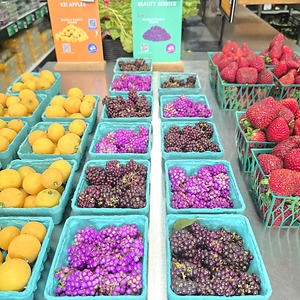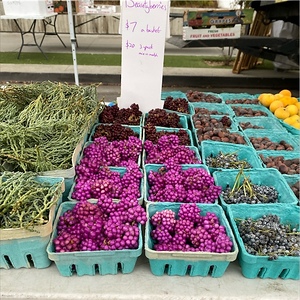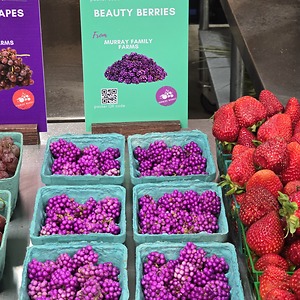


Beauty Berries
Estimated Inventory, bskt : 0
Description/Taste
Beauty berries are vibrantly colored fruits that grow on wild perennial shrubs. They develop in clusters that resemble miniature grapes since they’re made up of small rounded purple berries all bunched together. Each of these berries measures about ½ centimeter wide and contains 2 to 4 seeds that are around 1.5 centimeters in diameter. They typically possess a glossy, iridescent texture that can have bright purple, lavender, fuschia, purple-blue, white, or pink tones. Their hue may be intensely colored on parts of the berry while slightly faded at other parts. They can be hard or squishy depending on their point of maturity and eventually shrivel into a raisin-like form when overripe. Beauty berries are edible and known for having a mild taste that may be slightly tangy, astringent, and citrus-like with floral notes of hibiscus.
Seasons/Availability
Beauty berries are available in the fall.
Current Facts
Beauty berries are known botanically as Callicarpa americana and belong to the Verbenaceae family. They are more formally known as the American mulberry but also go by French mulberry, Perfumed cherry, ZiZhu, and Sourbush. These berries grow on shrubs that can reach anywhere from about 1 to 3 meters tall. The shrubs have long, arching branches with yellow and green leaves during the fall and bloom clusters of small pink flowers in the spring. There are many different varieties of Beauty berry shrubs, including Alba, Lactea, and Russell Montgomery, which have white berries, and Welch’s Pink, which have pink berries. The berries of this shrub are edible but not the main use of this plant. These plants are primarily utilized for their ornamental value as they are frequently sown in gardens or implemented into landscape borders. Beauty berries also provide food for birds and butterflies and their roots and leaves can be incorporated into a variety of medicinal applications.
Nutritional Value
Beauty berries are rich in vitamin C, which supports immune function, promotes healthy skin, and aids in collagen production. The high fiber content in these berries helps support digestive health, regulate blood sugar levels, and maintain a healthy weight. Beauty berries are high in antioxidants like anthocyanins, which not only give the berries their vibrant color but also help protect the body from oxidative stress and reduce inflammation. Beauty berries may be used to treat digestive issues, colic, irregular bowel movements, dropsy, inflammation, rheumatoid arthritis, edema, gout, dysentery, acne, and reflux. Their diuretic, antibacterial, antifungal, anti-inflammatory, and antioxidant properties make them useful in holistic medicine.
Applications
Beauty berries are edible and can be consumed after being thoroughly cleaned. They may be eaten raw, dried, or baked but are most often preserved to make jellies and jams, which can be enjoyed on toast, biscuits, croissants, and sandwiches or incorporated into baked goods like cakes and bars. These berries are also puréed to make a sauce for meats or cooked into holiday stuffings. When raw, Beauty berries can be tossed in salads, fruit bowls, yogurt parfaits, granola, and trail mix. This variety may also be mixed into berry wines, cocktails, infused waters, or green juices. Beauty berries can be frozen and incorporated into sorbet, smoothies, and acai bowls. They are complemented by the flavors of lemons, limes, oranges, grapefruit, peaches, apricots, cherries, plums, blackberries, blueberries, mint, basil, ginger, cinnamon, almonds, pistachios, and walnuts.
Ethnic/Cultural Info
Beauty berries grow all over the Southeastern region of the United States. They were valued by Native American tribes who used their leaves and roots in sweat baths and to treat rheumatism, fevers, and malaria. The Cherokees believed these berries had protective qualities that could ward off bad luck and evil spirits. They were particularly interested in how Beauty berries supported women's health and well-being, believing that consuming the berries or utilizing the plant's properties during pregnancy could help prevent negativity and illness.
Geography/History
Beauty berries are native to the Southeastern United States that spans from Texas and Oklahoma all the way east to Maryland. They flourish in dry, moist, and tropical climates and prefer locations with full sun exposure but can tolerate partial shade as well as drought. As a primarily foraged fruit, Beauty berries grow in wild environments like thickets, wet slopes, bottomlands, woodlands, coastal plains, ditches, roadsides, and on the edges of swamps, ponds, ditches, and streams. This variety may also be grown in gardens or sourced from farmers’ markets and specialty stores in their native regions as well as in Southern California. Their seeds can be purchased or retrieved from the wild to cultivate in home gardens.










